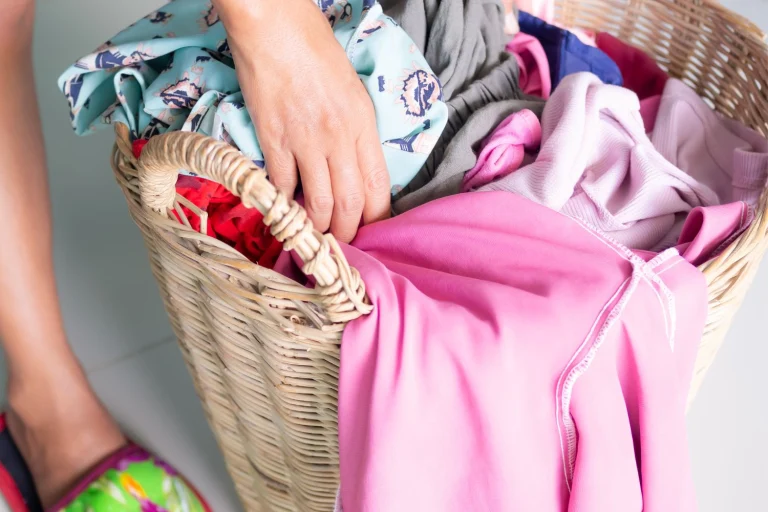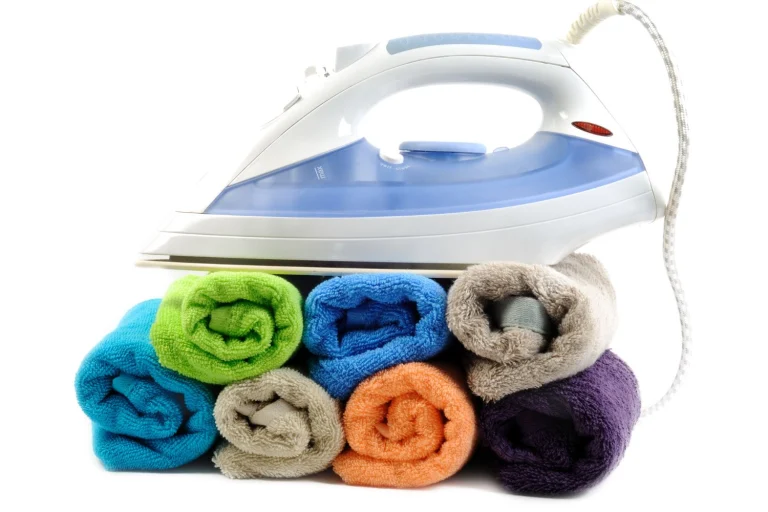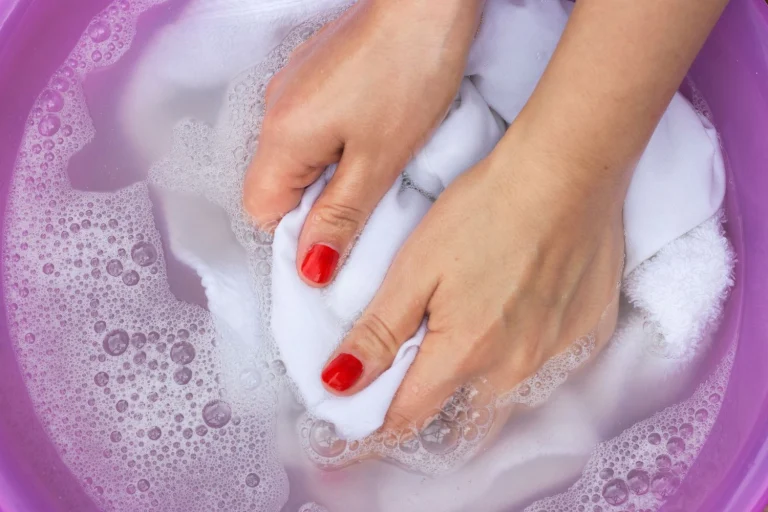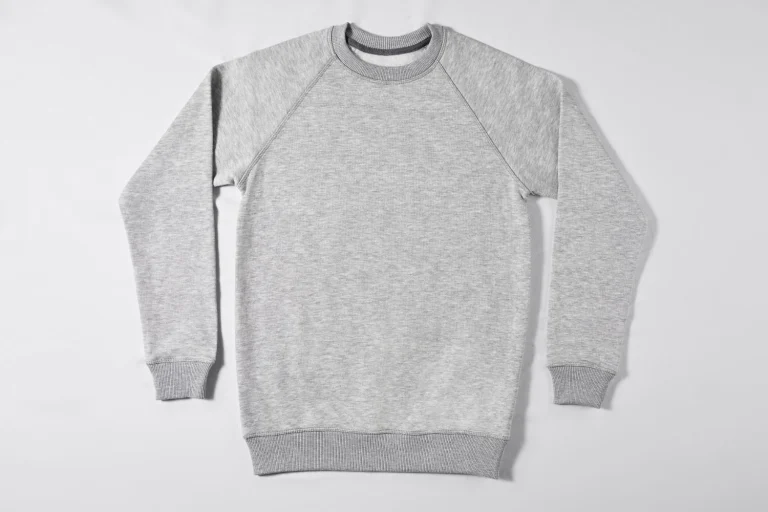When it comes to mixing light gray or colored items, there is always the worry that the dye in the fabric will bleed onto your pristine whites, and no one wants that!
Understanding colorfastness—the fabric’s ability to hold onto its dye without bleeding during a wash—is key in determining whether your light gray clothes are safe to wash with white ones.
Before you think about mixing different colors and fabrics, it’s wise to perform a simple test to check if the dye in your grays is stable. You can do this by dampening a small area of the fabric and pressing it with a white cloth to see if any dye transfers. Here’s more on how to check for colorfastness.
Sorting clothes by color is a fundamental laundry practice. However, the rules can have some flexibility depending on the fabric and dye strength of your garments.
Fabrics that include man-made fibers such as polyester and nylon tend to retain their colors, whereas natural fibers like cotton and linen are more likely to run and also get stained from other dark items in the wash.
This is the rule I like to abide by when mixing loads like light grays:
Light gray clothing can usually be washed with white items without issue, particularly if they’ve been washed before and did not release any dye in previous cycles.
Heads up: I sometimes use affiliate links. When you click these links and make a purchase, I may get a small commission. It won't cost you anything but it helps me to run this site.
Should you wash light gray items with darks?
When laundering, your gray clothes may either join the darks or whites based on their depth of color.
When to put light gray items in with the darks
If you have dark gray items or light gray clothes that you suspect might bleed, it’s safer to wash them with darks. This is especially important for new garments that haven’t been washed before, since dye transfer is more likely during the first few washes.
It’s best to put sturdy fabrics like denim or thick cotton in with the darks.
If you have concerns, use a color catcher sheet in the wash to absorb any excess dye.
When it’s fine to put light gray items in the whites
Light gray items are usually ok to wash with whites if they:
- Have been washed before without any color bleeding.
- Are made of colorfast materials that don’t fade.
If you’re combining light gray clothes with white clothes, select a cool temperature for the wash cycle to reduce the risk of color transfer.
How to sort your laundry

I always recommend sorting your washing if you can because it allows you to run a washing cycle more suitable to the fabrics and colors, and you can use the most effective detergent too.
Here’s a simple guideline:
- Whites: Pure white cotton, linen, and synthetic garments.
- Lights: Pastel colors, beige and light gray items.
- Darks: Deeply colored clothes like navy, black, red, and purple.
For various fabric types, consider their washing needs. Delicates should be washed separately on a gentle cycle, whereas towels and linens can tolerate more vigorous washing.
If you’re still concerned about colors bleeding, use a color catcher sheet with your mixed loads. They will trap any loose dye released during the wash cycle.
To sort clothes efficiently:
- Create piles for whites, lights, and darks.
- Further sort by fabric type if needed — for instance, keeping towels from lightweight fabrics.
- Check care labels for any special instructions.
- Pre-treat stains before adding clothes to the washer.
If you only have one very dark item that you think will bleed or fade, why not try handwashing your black clothing? The deep color will be preserved for longer.
How to wash whites with grays
When you prefer not to run another wash just for your light items, it’s fine to wash them together as long as you are sure all items are colorfast.
Here’s a guide to help you wash them together:
- Sort your laundry. Remove clothing from the wash that is likely to bleed onto other items.
- Check garment labels. Always check the care label for any specific washing instructions.
- Preparation. Pre-treat any stains for better results. Turn gray clothes inside out to preserve the color.
- Choosing detergent. Use a color-safe detergent to protect the darker fabrics.
- Select the wash cycle. Choose a gentle cycle if your fabrics are delicate. Cold water is generally safer for mixed loads to avoid setting stains and to prevent shrinking or fading.
- Add color-safe bleach (If necessary). For a brightness boost, add a small amount of color-safe bleach. I recommend an oxygen-based bleaching agent such as Oxiclean as its usually fine for colors too.
- Post-wash care. Check for any color transfer before drying. Dry whites and grays according to the garment’s label instructions.
Related post:
Keep in mind that new garments should be washed separately before joining a mixed load to prevent any color bleeding.
How to test for colorfastness

Testing for colorfastness is essential before washing light gray clothes with white ones to prevent color bleeding.
Here’s a simple method to check the colorfastness of your fabric:
- First, locate a hidden part of the garment, such as the inside seam or hem.
- Dampen a white cloth with water and lay it flat on a surface.
- Place the hidden part of the gray garment on top of the damp cloth.
- Press down on the garment with a warm iron for about 30 seconds.
- After ironing, examine the white cloth for any dye transfer. If the cloth picked up any color from the fabric, your garment is not colorfast and may bleed when washed with whites.
Alternatively, if you prefer not to use an iron:
- Wet a small area of the hidden part of the fabric with water.
- Place a piece of white paper towel or cloth on both sides of the wet area.
- Press firmly for a few minutes, then check the white material for any signs of dye.
Here’s a quick checklist to keep handy for your colorfastness test:
| Step | Description |
|---|---|
| Choose Hidden Area | Select inner seam or hem. |
| Prepare Test Materials | Damp white cloth; iron, or paper towel. |
| Apply Test | Iron for 30s or press for a few minutes. |
| Check for Bleeding | Look for dye transfer onto the white material. |
If the garment passes the colorfastness test, it’s likely safe to wash with white clothes. If there’s any doubt about the fabric’s colorfastness, wash it separately.
How to get gray clothes back to white

If your white garments have taken on a gray tint, here’s how you can restore them to their original brilliant white.
You’ll need:
- Oxygen bleaching agent
- Distilled white vinegar
- Laundry detergent
- Washing machine
Instructions:
- Pre-soak with Oxygen Bleach:
- Fill a sink or bucket with warm water.
- Add a scoop of oxygen bleach (check the product label for the correct amount).
- Submerge your grayed whites and let them soak for at least one hour.
- Washing Machine Cycle:
- Place your pre-soaked clothes in the washing machine.
- Add laundry detergent as you normally would.
- Add half a cup of distilled white vinegar to the fabric softener compartment.
- Set your washer to a warm, gentle cycle.
- Air Dry:
- Hang your clothes out to dry in the sun if possible. UV rays can help to naturally bleach and whiten fabrics.
Frequently asked questions
Mixing various colors with your white laundry can be safe if done correctly, focusing on the color stability and fabric type to maintain your clothing’s pristine condition.
What colors are safe to mix with white laundry?
You can safely mix whites with light colors that are colorfast, such as pale pastels or light gray. Always perform a colorfastness test on new garments to ensure they don’t bleed color into your white items.
Is it okay to wash light gray items with white garments?
Washing light gray items with white garments is generally okay as long as the gray items are colorfast and won’t release dye during the washing process.
Should white clothes always be washed separately, or can they be combined with light colors?
White clothes don’t always have to be washed separately. They can be combined with light colors if those colors are colorfast. Sorting by fabric type is also important so that heavy garments don’t damage delicate whites.
What’s the best method to launder white and light-colored clothing together?
To launder white and light-colored clothing together, use a mild detergent and cold water setting. Avoid bleach with color fabrics, even light ones, unless the product is color-safe bleach that specifically states it’s suitable for colors.
Can light blue items be included in a white laundry load?
Light blue clothing items might be included with white laundry if they are colorfast and washed in cold water, which minimizes the risk of dye transfer.
How can you clarify what is considered ‘white’ laundry?
‘White’ laundry is identified by its lack of color or patterns. For the best results, consider a garment white only if it is completely or predominantly white without significant colored sections that could bleed during washing.












